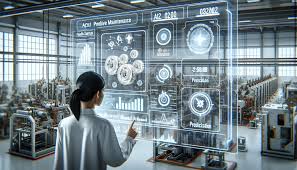Revolutionizing Predictive Maintenance: How AI is Transforming Industrial Reliability
Key Takeaways
- Discover how AI is reshaping predictive maintenance and enhancing industrial reliability.
- Learn about the benefits of predictive maintenance in reducing costs and improving efficiency.
- Understand how AI algorithms predict and prevent machine failures.
- Explore real-life examples of industries successfully implementing AI-driven maintenance.
Table of Contents
- Introduction to Predictive Maintenance
- The Role of AI in Enhancing Reliability
- Benefits of AI-Powered Predictive Maintenance
- How AI Algorithms Work in Predicting Failures
- Real-World Applications and Case Studies
- Challenges and Considerations
- Future Trends in Predictive Maintenance
- Conclusion: The Path Ahead for AI in Maintenance
Introduction to Predictive Maintenance
A significant departure from the traditional maintenance techniques that companies have depended on for many years is represented by predictive maintenance. Traditionally, maintenance was either conducted at regular intervals regardless of need, known as periodic maintenance, or after a failure, termed corrective maintenance. These approaches had inherent inefficiencies, leading to unnecessary maintenance activities or causing expensive downtimes due to unforeseen breakdowns. In contrast, predictive maintenance leverages data-driven analysis to anticipate equipment failures before they occur. This approach minimizes unnecessary servicing and helps keep machinery running efficiently. Many industries are now manufacturing predictive maintenance software to gain insights into equipment health, leading to cost savings and enhanced operational reliability.
The Role of AI in Enhancing Reliability
Artificial Intelligence (AI) serves as a transformative force in the domain of predictive maintenance. AI is unparalleled in its capacity to process enormous volumes of data in real time and identify significant patterns. Industries can gain deeper insights into their machinery’s operational health by integrating AI with existing maintenance protocols. Artificial intelligence (AI) systems employ machine learning techniques to continuously monitor sensor data from equipment, identify anomalies that may signal impending malfunctions, and identify typical operating trends. Such capabilities propel industries toward a proactive maintenance culture, drastically reducing unforeseen downtimes and enhancing equipment lifespan. Extensive research, like the one in this study, underscores AI’s critical role in revolutionizing equipment maintenance and reliability.
Benefits of AI-Powered Predictive Maintenance
AI-powered predictive maintenance offers several compelling benefits that industrial leaders cannot afford to ignore. One of the most significant advantages is the reduction in maintenance costs. These savings stem from the ability to perform maintenance activities only when necessary, based on predictive data, rather than following a rigid maintenance schedule. This approach conserves resources and extends the equipment’s life, as machines are not subjected to unnecessary interventions. Additionally, by reducing unexpected failures, AI-driven maintenance enhances the safety environment for workers and ensures high levels of productivity. With machinery operating at optimal levels due to predictive insights, industries can focus on strategic objectives rather than maintenance woes.
How AI Algorithms Work in Predicting Failures
The intricacies of AI algorithms in predicting equipment failures encompass sophisticated processes that employ historical data for training and future prediction. These algorithms develop predictive models by identifying patterns and correlations within massive datasets. Initially, they determine a machine’s normal operational behavior by examining historical and real-time data. Once the normal state is established, the AI system constantly monitors for deviations from this state, which indicate potential mechanical issues. When anomalies are detected, alerts are triggered, allowing maintenance teams to investigate and address the problems before they manifest as equipment failures. Insights from advanced studies, such as those discussed in scientific literature, reveal the efficiency and potential of AI algorithms in vastly improving maintenance reliability and accuracy.
Real-World Applications and Case Studies
Numerous industries have successfully implemented AI-driven predictive maintenance with remarkable results. Take the rail sector, where businesses use AI technology to regularly check train engines and related parts for wear or malfunctions. This approach has significantly improved the punctuality and safety of rail services, serving as a testament to the efficacy of AI in maintenance. Similarly, in manufacturing, AI systems use data collected from sensors on production lines to monitor machinery health. This continuous oversight allows adjustments and repairs to be made exactly when needed, reducing downtime, maintaining consistency in production quality, and elevating customer satisfaction.
Challenges and Considerations
Even though AI-based predictive maintenance has many benefits, several issues must be resolved before its full potential can be realized. A significant hurdle is the quality and completeness of the data used to train AI models. Inaccuracies or gaps can lead to erroneous predictions. Furthermore, integrating AI technology into existing infrastructure can pose technical and logistical challenges, often requiring substantial investment. The shortage of skilled people with experience in AI and predictive analytics is another challenge. To overcome these challenges, industries must prioritize comprehensive training programs for their workforce and invest in robust data integration and management systems that facilitate seamless operation.
Future Trends in Predictive Maintenance
The future of predictive maintenance appears promising, with advancements in AI and IoT paving the path for even more revolutionary approaches. Integrating IoT devices with AI systems will enhance predictive capabilities by providing more granular data in real-time. As these technologies evolve, we anticipate the emergence of fully autonomous maintenance systems capable of making decisions and executing interventions without human intervention. This aspiration brings us closer to a future of zero-downtime industries, where equipment reliability is ensured, and productivity is maximized. Such progression will redefine maintenance practices and open doors for innovation and sustainability in industrial operations.
Conclusion: The Path Ahead for AI in Maintenance
The advent of AI in predictive maintenance marks a pivotal change in how industries manage and maintain their equipment. By embracing these advanced technologies, companies gain significant benefits, from enhanced reliability and operational efficiencies to greater innovation and environmental sustainability. Predictive maintenance will surely benefit from AI’s growing role as it develops, bringing new capabilities and industry standards. The future is promising for those willing to invest in AI-driven methodologies, heralding a new era where reliability and productivity are at the forefront of industrial operations.

